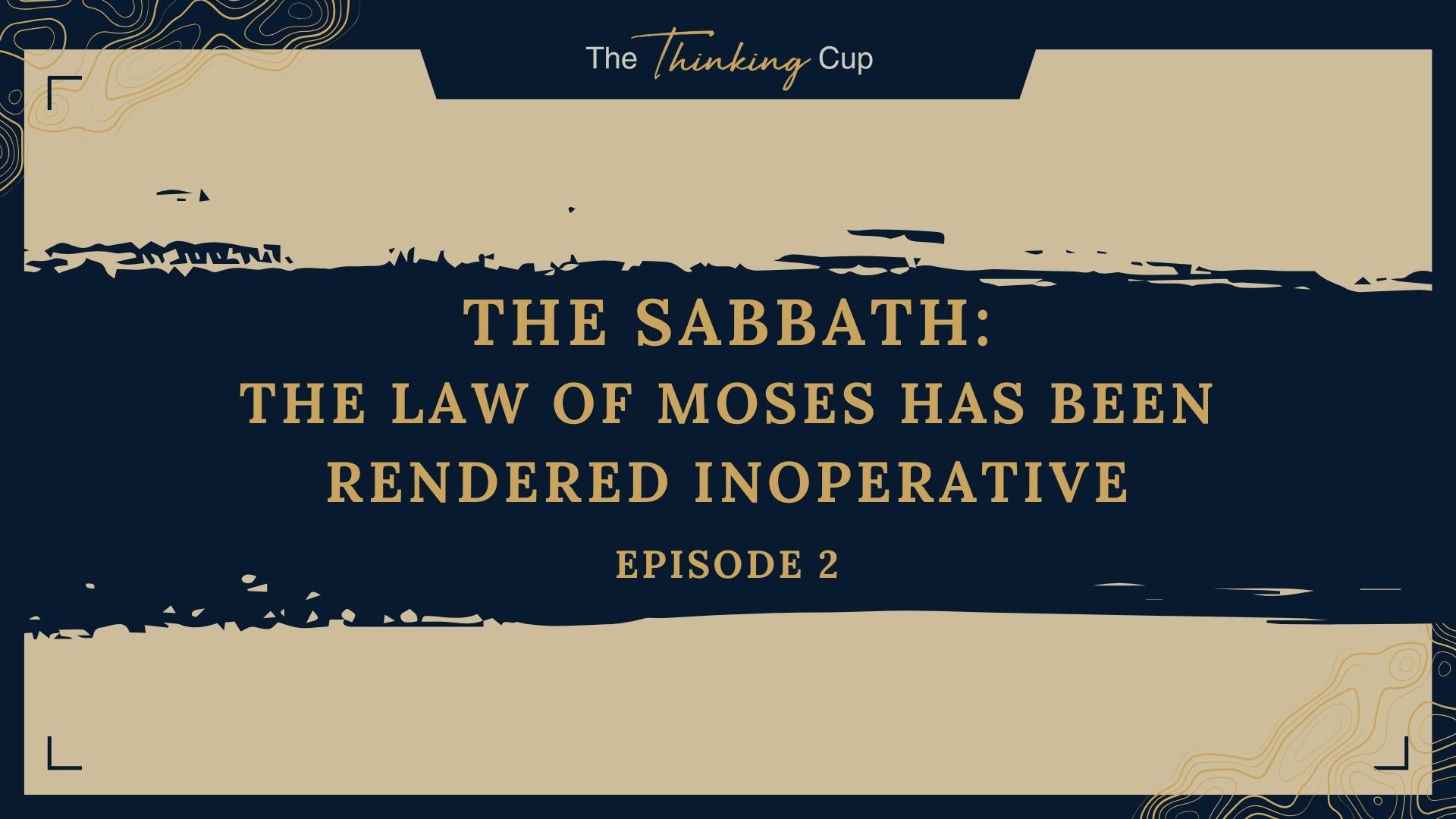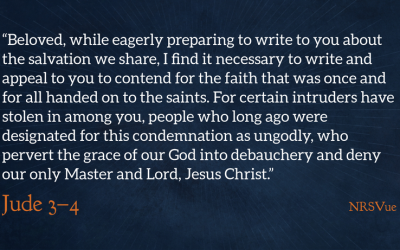The New Testament clearly teaches that the Law of Moses has been rendered inoperative following the death of Christ. This means that the law, in its entirety, no longer holds authority over any individual. Paul explains this in Romans 7:1–6, using the analogy of marriage to illustrate the believer’s relationship to the law.
“Or do you not know, brothers—for I am speaking to those who know the law—that the law is binding on a person only as long as he lives? For a married woman is bound by law to her husband while he lives, but if her husband dies she is released from the law of marriage. Accordingly, she will be called an adulteress if she lives with another man while her husband is alive. But if her husband dies, she is free from that law, and if she marries another man she is not an adulteress. Likewise, my brothers, you also have died to the law through the body of Christ, so that you may belong to another, to him who has been raised from the dead, in order that we may bear fruit for God. For while we were living in the flesh, our sinful passions, aroused by the law, were at work in our members to bear fruit for death. But now we are released from the law, having died to that which held us captive, so that we serve in the new way of the Spirit and not in the old way of the written code.” (Romans 7:1–6, ESV)
Just as a wife is bound to her husband only as long as he is alive but is freed from that obligation upon his death, so too have believers been released from the law through the death of Christ. Paul explicitly states, “you also have died to the law through the body of Christ” (Rom. 7:4), emphasizing that the law no longer serves as the governing rule for believers. He further declares, “But now we are released from the law” (Romans 7:6, ESV), making it clear that the Mosaic Law no longer has authority over those in Christ. One cannot be bound to both the Law and the Messiah simultaneously—one must belong to Christ alone.
Another crucial passage affirming this truth is Romans 10:4, where Paul writes,
“For Christ is the end (telos) of the law for righteousness to everyone who believes.” (Romans 10:4, ESV)
The Greek word telos, translated as “end,” carries the meaning of “termination” rather than merely “goal.” This is confirmed by Greek scholars such as Thayer, who defines telos primarily as:
“τέλος (telos) termination, the limit at which a thing ceases to be” [1]
Bauer and Danker in their acclaimed lexicon A Greek-English Lexicon of the New Testament and Other Early Christian Literature, 3rd ed. (BDAG), similarly state that the word means:
“a point of time marking the end of a duration, end, termination, cessation” [2]
While it is true that Christ is also the goal of the law, the emphasis in this passage is that He has brought the law to an end. This means that justification is no longer found through the law:
“…we know that a person is not justified by works of the law but through faith in Jesus Christ, so we also have believed in Christ Jesus, in order to be justified by faith in Christ and not by works of the law, because by works of the law no one will be justified.” (Galatians 2:16, ESV)
Also, the law does not provide sanctification or perfection:
“(for the law made nothing perfect); but on the other hand, a better hope is introduced, through which we draw near to God.” (Hebrews 7:19, ESV)
It is biblically clear that the law has ceased to function in both respects for believers.
Additionally, Galatians 3:19 reinforces the temporary nature of the Mosaic Law, stating,
“Why then the law? It was added because of transgressions, until the offspring should come to whom the promise had been made…” (Galatians 3:19, ESV)
Here, Paul clarifies that the Law of Moses was an addition to the Abrahamic Covenant for a specific purpose—to reveal sin—until Christ (the promised seed) arrived. Now that He has come, the law has fulfilled its role and is no longer in effect. The law, which was a temporary measure, ended with the cross.
A fundamental change also occurred in the priesthood with the coming of Christ. Hebrews 7:11–18 explains that a change in the law was necessary with the establishment of a new priesthood according to the order of Melchizedek. Under the Mosaic system, only the Levitical priesthood was permitted to function. Since Christ’s priesthood is of a different order, the Mosaic Law HAD to be set aside.
Hebrews 7:18 states,
“For, on the one hand, there is the nullification of a former commandment because of its weakness and uselessness” (Hebrews 7:18, NASB 2020)
The word translated nullification is best understood as the act of officially or legally canceling something. [3] Because the law was tied to the Levitical priesthood, and that priesthood has been replaced, the Law of Moses is no longer valid. If the law were still in effect, Jesus could not function as a priest since He was not from the tribe of Levi. (This point cannot be understated! Since the Adventist system understands the law as eternally binding, they effectively nullify Jesus’ ability to function as our High Priest.) However, since the Mosaic Law has been annulled, Christ can now serve as the High Priest under a new and superior covenant.
Ephesians 2:14–15 further confirms the abolition of the Mosaic Law, stating that Christ:
“…has broken down in his flesh the dividing wall of hostility by abolishing the law of commandments expressed in ordinances.” (Ephesians 2:14–15, ESV)
The law functioned as a barrier, separating Jews and Gentiles, but through His death, Christ removed that division, allowing Gentiles to fully partake in the spiritual blessings of God’s covenants. If the Mosaic Law were still in effect, this barrier would remain, preventing Gentiles from freely accessing the promises given in Christ.
Galatians 3:23–4:7 describes the law as a paidagogus, or tutor/guardian, meant to lead people to Christ. Once faith in Christ is established, Paul declares,
“…we are no longer under a guardian, for in Christ Jesus you are all sons of God, through faith.” (Galatians 3:25–26, ESV)
This statement is unambiguous—the Law of Moses no longer governs believers.
Another significant passage reinforcing the annulment of the law is 2 Corinthians 3:2–11 (ESV), where Paul refers specifically to the Ten Commandments, calling them the “ministry of death” (2 Cor. 3:7, ESV) and the “ministry of condemnation” (2 Cor. 3:9, ESV). While many attempt to retain the Ten Commandments as still binding, Paul states that they have “been brought to an end” (2 Cor. 3:11, ESV). The Greek word katargeo, used in this passage, literally means “to render inoperative.” BDAG correctly asserts that this word should be understood in this verse as,
“to cause something to come to an end or to be no longer in existence, abolish, wipe out, set aside” [4]
This means that even the Ten Commandments, as part of the Mosaic Law, are no longer in effect as a rule of life for believers. The superiority of the Law of Christ lies in the fact that it will never be rendered inoperative, unlike the Mosaic Law, which has been set aside, abolished, and wiped out.
You may find an Adventist arguing against this interpretation by citing Matthew 5:17–18, where Jesus states, (KJV intentionally used since the argument is coming from an Adventist)
“Think not that I am come to destroy the law, or the prophets: I am not come to destroy, but to fulfil. For verily I say unto you, Till heaven and earth pass, one jot or one tittle shall in no wise pass from the law, till all be fulfilled.” (Matthew 5:17–18, KJV)
However, as Stanley Toussaint explains, the word fulfill means to bring to completion, not to perpetuate (Behold The King, p. 99). [5] Christ fulfilled the law by living in perfect obedience to it and by accomplishing its prophetic requirements. This understanding aligns with how Matthew consistently uses the term fulfill in reference to prophecy—once fulfilled, the prophecy is complete and no longer awaiting further fulfillment. Jesus’ words in Matthew 5:17–19 should not be misinterpreted to argue for the continued authority of the Mosaic Law but should instead be understood as a declaration of the authority of Scripture and the fulfillment of the Messianic prophecy foretold in the Old Testament.[6] The Law of Moses remained in effect until Christ’s death, at which point it was fulfilled and set aside.
Furthermore, the moral law, which reflects the eternal nature of God, did not begin with Moses nor did it terminate with Christ. As McQuilkin explains,
“The moral law is not equivalent to the Mosaic Law. However, the Mosaic law, which was ‘added’ because of transgressions, included the moral law. It included also the ceremonial law, civil law, criminal law, sanitary law, governmental law. But the moral law existed before Moses, and continues after the Cross.” [7]
This excerpt is cited in Roy L. Aldrich’s article “Causes for Confusion of Law and Grace,” published in Bibliotheca Sacra. Aldrich references McQuilkin’s distinction between the moral law and the Mosaic Law to clarify common misunderstandings in theological discussions. The Law of Moses included moral commandments, but it was not the source of morality itself. These moral principles are now embodied in the Law of Christ, which believers are called to follow.
To summarize, the Law of Moses, as a unified system of 613 commandments, has been rendered inoperative. It no longer functions as an authority over believers, though it remains valuable as a teaching tool to reveal God’s righteousness, man’s sinfulness, and the necessity of Christ’s atoning work (Gal. 3:23–25). The moral principles found within the Mosaic Law continue, not because of the Law of Moses, but because they are part of the unchanging character of God, now expressed through the Law of Christ. The Seventh-day Adventists’ repeated claims that the Mosaic Law remains in effect while simultaneously ignoring large portions of it reflect a theological inconsistency that does not align with Scripture. Christ fulfilled the law and, in doing so, brought it to its intended conclusion. Believers now live under a new and superior covenant governed by the Law of Christ.
In Christian Love,

[1] Joseph Henry Thayer, A Greek-English Lexicon of the New Testament: Being Grimm’s Wilke’s Clavis Novi Testamenti (New York: Harper & Brothers., 1889), 619-620.
[2] William Arndt et al., A Greek-English Lexicon of the New Testament and Other Early Christian Literature (Chicago: University of Chicago Press, 2000), 998.
[3] Idib, 24.
[4] Idib, 525.
[5] Stanley D. Toussaint, Behold the King: A Study of Matthew (Grand Rapids, Mich: Kregel Academic, 2005).
[6] Robert P. Lightner, “Theological Perspectives on Theonomy Part 3: A Dispensational Response to Theonomy,” Bibliotheca Sacra 143 (1986): 230.
[7] Roy L. Aldrich, “Causes for Confusion of Law and Grace,” Bibliotheca Sacra 116 (1959): 225.




0 Comments